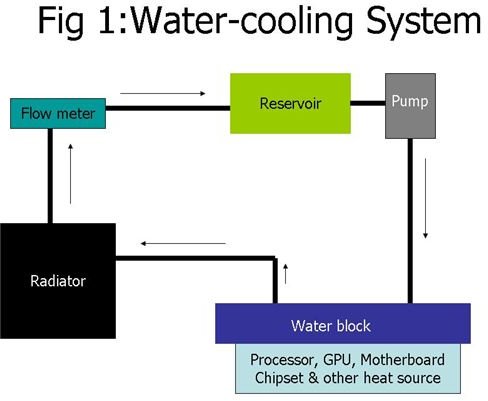PC Water Cooling Accessories
Introduction
There can be several reasons you may want to adopt water cooling for your PC. More performance is usually one of the reasons users may want to squeeze out every last bit of processing power out of their PCs. Alternately you may want this higher power with higher graphics performance to make high performance gaming possible. Usually this means pushing the CPU, the GPU and other system components to higher clock speeds.
Over-clocking always results in these components dissipating more heat. The traditional air cooling may not suffice and you may have to add water cooling to the system. You can buy complete PC cases equipped with water cooling or install a cooling system yourself. A third alternative is to use an external cooling system that is easy to hook up to existing PC electronics. The following is a quick introduction to what components/accessories make up a water cooling system.
Water cooling Accessories
Fig 1 below is a diagram that shows how PC water cooling accessories are connected together to make a complete system.
The pump pushes out water to the water block. The water block is the main accessory of the cooling system. It replaces the standard heat sink, which again is a block of metal. It is a metal block through which water can circulate and take away the heat being generated at the heat source. The hot water flows out to the next PC water cooling accessory, the radiator. This too is built of metal and has fins to make cooling of the hot water coming out of the water block easier. The water cooled through the radiator then flows through the flow-meter (optional) to the reservoir. The flow-meter is nothing more sophisticated than a set of fan blades that rotates as the water flows through it. It shows you if the water is actually flowing through the set of tubing round the path just described. You may or may not have this accessory in the loop. The pump keeps forcing out water from the reservoir to keep up the cooling cycle.
The only other accessories that are required are tubes, connectors, and special liquid. Water cooling is something of a misnomer, as more commonly used are liquids that will do a better job of moving heat and cause less damage to your system should a leak occur. Each of the PC water cooling accessories have a inlet and a outlet where you can attach the tubes by turning the connectors set at the end of the tubes. You need to connect one outlet to the next inlet until you have a complete loop.
Setting up the Water Cooling Accessories
You can buy a complete external cooling system that uses tubes to get liquid into and out of the water blocks in the case (on the CPU, for example). What that means is, except for the water block(s), this external water cooling accessory has everything else inside of it. The unit would contain the pump and a reservoir as well as the radiator. Depending on the sophistication, these may have temperature indicators. Attaching the water block to the target chip and attaching the inlet and outlet tubes are all that is required to get these kinds of systems going.
A third approach to a PC water cooling system would be the DIY approach. You buy all the accessories individually and install the system yourself. You will need to find ways to install each of these components inside your PC case and make sure they work effectively. Particularly, the radiator must be able to cool the circulating water properly.
It is possible to cool multiple components inside the PC. Water tubes will have to create the cooling loops through the multiple water blocks, of course. Tube splitters are available that let you create these additional paths quite easily.
Some Precautions
When a water block is installed it is necessary to create a good thermal conduction interface between the chip top surface and the bottom surface of the water block. Using a thermal grease is necessary. If you are replacing a standard heat sink with a water block, it is necessary that the grease used originally on the heat sink is first cleaned up and then a fresh coat is applied.
As the liquid spilling anywhere in the PC water cooling loop can cause electrical problems in your PC, you must check for any leakage from any of the PC water cooling accessories in your system. This is vital. Even when using a special dielectric liquid that is less conductive than water, electical issues can arise, and if a leak goes unnontice, the water cooling accessories may run dry, possibly causing damage to themselves and parts of the computer that won’t be getting any cooling.
Availability of Water Cooling Accessories
Quite a few manufacturers sell these PC water cooling accessories. Some examples are HighspeedPC (https://highspeedpc.com/), CrazyPC (https://crazypc.com/) and Koolance (https://koolance.com/default.php). This is not a specific endorsement of the particular products or retailers, just some representative samples.
